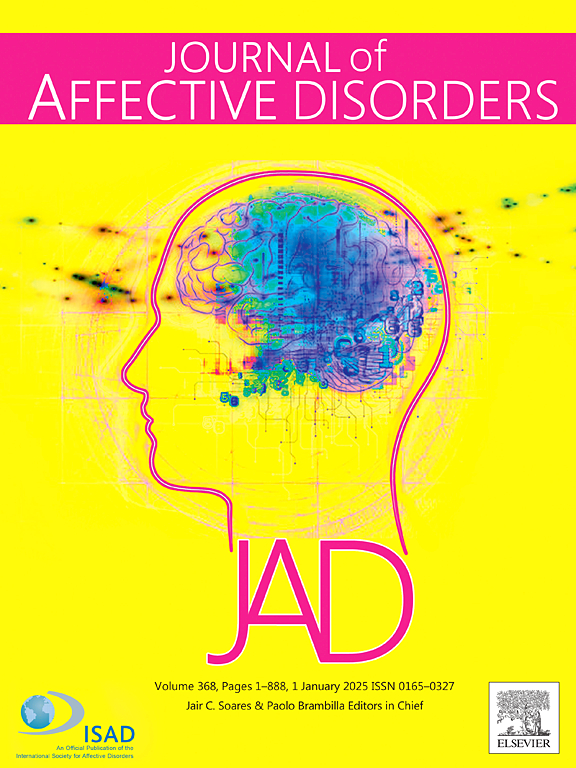Depressive symptoms in individuals with overweight and obesity. Results from the LIFE-adult-study
IF 4.9
2区 医学
Q1 CLINICAL NEUROLOGY
引用次数: 0
Abstract
Background
Prevalences of overweight and obesity are rising worldwide. Comorbidity of depressive symptoms and overweight or obesity are considered as a major public (mental) health issue. The aim was to determine prevalences in a non-treatment seeking population of adults, investigating possible confounders as well as interaction effects.
Methods
The overall sample included 6200 participants aged 40 to 80 years from the LIFE-Adult-Study. Body Mass Index (BMI), symptoms of depression, somatic complaints, as well as health-related factors were surveyed using validated instruments.
Results
Overall, 5.5 % of individuals with overweight and 7.3 % of individuals with obesity reported depressive symptoms in the past 7 days, compared to 5.8 % of individuals without obesity/overweight. At total, the prevalence of depressive symptoms was 2.2 % among individuals with overweight and 1.7 % among individuals with obesity. Multivariate regression models revealed an overall positive association between BMI and depressive symptoms (β = 0.031, p = 0.001), adjusting for covariates. Moreover, being unmarried, higher age, low or medium SES, more somatization and medium physical activity was significantly linked to severity of depressive symptoms.
Conclusions
The results underline the importance of addressing comorbidity in research and practice. While the overall number of people with both obesity and depressive symptoms in the population is low, individuals with obesity may be more vulnerable to experience depression than those without obesity. Comorbidity may be associated with consequences on overall health and quality of life. Further research is needed, especially longitudinal studies in order to explain the role and causality of socio-demographic or health-related factors.
超重和肥胖个体的抑郁症状。来自LIFE-adult-study的结果
世界范围内超重和肥胖的患病率正在上升。抑郁症状和超重或肥胖的共病被认为是一个主要的公共(精神)健康问题。目的是确定未寻求治疗的成人人群的患病率,调查可能的混杂因素以及相互作用的影响。方法总体样本包括6200名来自LIFE-Adult-Study的年龄在40至80岁之间的参与者。身体质量指数(BMI)、抑郁症状、躯体主诉以及与健康相关的因素均使用经过验证的仪器进行调查。结果总体而言,5.5%的超重个体和7.3%的肥胖个体在过去7天内报告了抑郁症状,而非肥胖/超重个体的这一比例为5.8%。总的来说,抑郁症状的患病率在超重人群中为2.2%,在肥胖人群中为1.7%。多变量回归模型显示BMI与抑郁症状之间总体正相关(β = 0.031, p = 0.001),校正协变量。此外,未婚、年龄较大、低或中等社会地位、更多的躯体化和中等的身体活动与抑郁症状的严重程度显著相关。结论研究结果强调了在研究和实践中解决合并症的重要性。虽然在人群中同时患有肥胖和抑郁症状的人数很少,但肥胖的人可能比没有肥胖的人更容易患抑郁症。合并症可能与对整体健康和生活质量的影响有关。需要进一步的研究,特别是纵向研究,以解释社会人口或健康相关因素的作用和因果关系。
本文章由计算机程序翻译,如有差异,请以英文原文为准。
求助全文
约1分钟内获得全文
求助全文
来源期刊

Journal of affective disorders
医学-精神病学
CiteScore
10.90
自引率
6.10%
发文量
1319
审稿时长
9.3 weeks
期刊介绍:
The Journal of Affective Disorders publishes papers concerned with affective disorders in the widest sense: depression, mania, mood spectrum, emotions and personality, anxiety and stress. It is interdisciplinary and aims to bring together different approaches for a diverse readership. Top quality papers will be accepted dealing with any aspect of affective disorders, including neuroimaging, cognitive neurosciences, genetics, molecular biology, experimental and clinical neurosciences, pharmacology, neuroimmunoendocrinology, intervention and treatment trials.
 求助内容:
求助内容: 应助结果提醒方式:
应助结果提醒方式:


